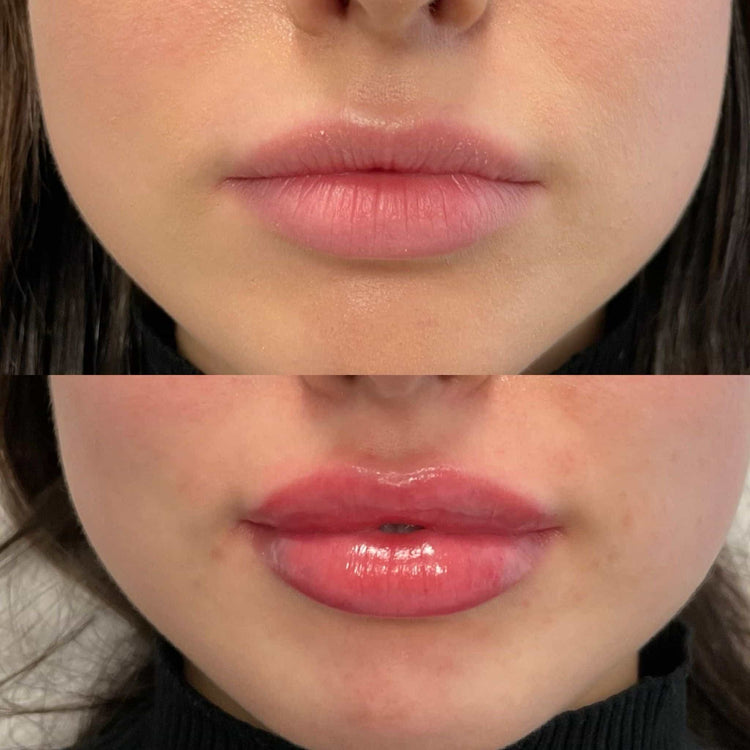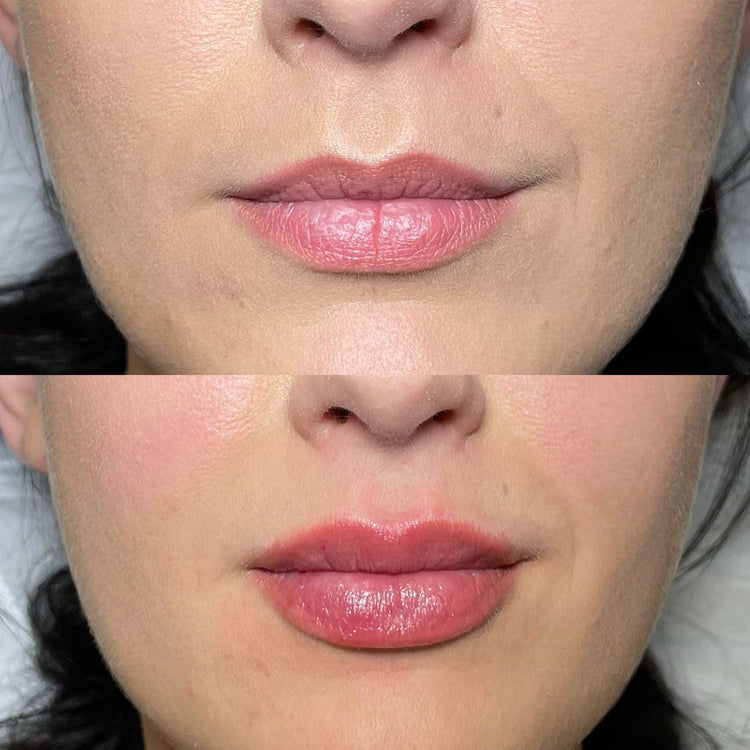Choosing the Right Filler
Dermal fillers have become increasingly popular for enhancing facial features and smoothing wrinkles, but choosing the right filler for your needs is crucial. Incorrect filler selection can lead to unnatural-looking results or, worse, complications like overfilling and distortion of facial expressions. Understanding the different types of fillers and their unique properties will help you make an informed decision and achieve a more natural, youthful appearance.
Consult with an Experienced Injector
Choosing the right dermal filler is essential for achieving desirable aesthetic results. Different fillers are formulated with varying viscosities, compositions, and intended applications. Hyaluronic acid-based fillers, such as Juvederm and Restylane, are popular for volumizing cheeks, smoothing wrinkles, and enhancing lips. These fillers attract and retain moisture, providing a natural-looking plumpness. Calcium hydroxylapatite (CaHA) fillers, like Radiesse, offer a more structured support for deeper wrinkles and contouring, while poly-L-lactic acid (PLLA) fillers, like Sculptra, stimulate collagen production for long-lasting volume restoration.
Understanding Different Fillers
Understanding the purpose of each filler type is key to avoiding overfilling. Hyaluronic acid fillers are best suited for fine lines and subtle enhancements, as they offer a more pliable consistency that can be easily molded. For deeper wrinkles or areas requiring significant volume restoration, CaHA fillers provide a firmer structure that can lift and support sagging skin. PLLA fillers work gradually, building collagen over time, making them ideal for addressing age-related volume loss in the face.
Considering Facial Anatomy
When selecting dermal fillers, considering facial anatomy is crucial to achieve natural-looking results and avoid overfilling. Each facial area has unique structural characteristics that require specific filler properties.
For example, the delicate skin around the eyes necessitates a lightweight filler with a low viscosity to prevent puffiness or unnatural bumps. The cheeks, requiring volume restoration, benefit from thicker fillers that can provide long-lasting support and lift. The lips, often treated for enhancement, require a pliable filler that allows for precise sculpting and definition.
Consulting with an experienced injector who understands facial anatomy and the nuances of different filler types is essential. They can assess your individual needs, discuss realistic expectations, and tailor a treatment plan to achieve optimal results while minimizing the risk of overfilling or unnatural-looking outcomes.
Proper Injection Technique
Proper injection technique is paramount when using dermal fillers to ensure natural-looking and desirable results. Injecting fillers too deeply or excessively can lead to undesirable outcomes such as lumpiness, distortion, or overfilled areas. Understanding the specific properties of each filler type and its intended application is crucial for achieving a harmonious balance in facial features.
Volume Management during Treatment
Volume management during treatment with dermal fillers is essential for achieving natural-looking results and avoiding overfilling. Injecting too much filler can lead to unnatural-looking contours, distortion of facial expressions, or even complications such as vascular occlusion.
Injectors should gradually add small amounts of filler while carefully assessing the results and making adjustments as needed. It is important to avoid injecting in one spot for extended periods as this can concentrate filler and create unevenness.
It’s crucial to use a blunt cannula or fine needles designed for dermal fillers, allowing for precise placement and minimizing bruising and trauma to surrounding tissues. Proper injection angles and depth are also critical to ensuring the filler is distributed evenly and effectively.
Strategic Placement and Spread
Strategic placement and spread of dermal fillers are vital for achieving natural-looking results. Injectors should carefully consider the facial anatomy and individual patient needs when determining the ideal placement and distribution of filler.
For example, to enhance cheek volume, filler is typically injected into specific points along the cheekbone, creating a gradual lift and contour. When addressing wrinkles around the eyes, careful placement is essential to avoid puffiness or unnatural bumps. Spreading the filler evenly beneath the wrinkle allows for softening without overfilling the area.
When treating the lips, injecting filler slightly beyond the vermillion border can create a natural-looking fullness and definition. Avoiding overly aggressive injections in one area is crucial to prevent lumps or an artificial appearance.
Avoiding Over-Injection in One Area
Choosing the right dermal filler is essential for achieving desirable aesthetic results. Different fillers are formulated with varying viscosities, compositions, and intended applications. Hyaluronic acid-based fillers, such as Juvederm and Restylane, are popular for volumizing cheeks, smoothing wrinkles, and enhancing lips. These fillers attract and retain moisture, providing a natural-looking plumpness. Calcium hydroxylapatite (CaHA) fillers, like Radiesse, offer a more structured support for deeper wrinkles and contouring, while poly-L-lactic acid (PLLA) fillers, like Sculptra, stimulate collagen production for long-lasting volume restoration.
Understanding the purpose of each filler type is key to avoiding overfilling. Hyaluronic acid fillers are best suited for fine lines and subtle enhancements, as they offer a more pliable consistency that can be easily molded. For deeper wrinkles or areas requiring significant volume restoration, CaHA fillers provide a firmer structure that can lift and support sagging skin. PLLA fillers work gradually, building collagen over time, making them ideal for addressing age-related volume loss in the face.
When selecting dermal fillers, considering facial anatomy is crucial to achieve natural-looking results and avoid overfilling. Each facial area has unique structural characteristics that require specific filler properties.
For example, the delicate skin around the eyes necessitates a lightweight filler with a low viscosity to prevent puffiness or unnatural bumps. The cheeks, requiring volume restoration, benefit from thicker fillers that can provide long-lasting support and lift. The lips, often treated for enhancement, require a pliable filler that allows for precise sculpting and definition.

Consulting with an experienced injector who understands facial anatomy and the nuances of different filler types is essential. They can assess your individual needs, discuss realistic expectations, and tailor a treatment plan to achieve optimal results while minimizing the risk of overfilling or unnatural-looking outcomes.
Realistic Expectations and Communication
Achieving natural-looking results with dermal fillers requires a clear understanding of realistic expectations and effective communication between patient and injector.
Discussing Desired Outcome with the Injector
Before undergoing any dermal filler treatment, it’s essential to have a candid conversation with your injector about your desired outcome. Clearly express your goals and aspirations for the treatment, but also be open to their expert advice and guidance.
Share any concerns or hesitations you might have regarding overfilling or unnatural-looking results. A skilled injector will listen attentively, assess your facial features, and explain the potential outcomes based on your individual needs and preferences.
Together, you can determine realistic expectations for the treatment and develop a customized plan that aligns with your aesthetic goals while minimizing the risk of undesirable consequences.

Setting Realistic Goals
Understanding realistic expectations is crucial when considering dermal fillers. It’s important to remember that fillers enhance natural features, not drastically transform them. Open communication between you and your injector is vital for achieving the desired outcome.
Before treatment, discuss your goals openly and honestly. Share any concerns or anxieties you have about overfilling or unnatural results. Your injector should provide a realistic assessment of what can be achieved, taking into account your facial structure, skin type, and individual preferences.
Remember that achieving optimal results often involves multiple treatment sessions spaced apart to allow for gradual improvement. Don’t hesitate to ask questions throughout the process to ensure you fully understand the procedure, potential risks, and expected outcomes.
Checking In During Treatment
Achieving natural-looking results with dermal fillers requires a clear understanding of realistic expectations and effective communication between patient and injector. Before undergoing any dermal filler treatment, it’s essential to have a candid conversation with your injector about your desired outcome. Clearly express your goals and aspirations for the treatment, but also be open to their expert advice and guidance. Share any concerns or hesitations you might have regarding overfilling or unnatural-looking results. A skilled injector will listen attentively, assess your facial features, and explain the potential outcomes based on your individual needs and preferences. Together, you can determine realistic expectations for the treatment and develop a customized plan that aligns with your aesthetic goals while minimizing the risk of undesirable consequences.
Understanding realistic expectations is crucial when considering dermal fillers. It’s important to remember that fillers enhance natural features, not drastically transform them. Open communication between you and your injector is vital for achieving the desired outcome. Before treatment, discuss your goals openly and honestly. Share any concerns or anxieties you have about overfilling or unnatural results. Your injector should provide a realistic assessment of what can be achieved, taking into account your facial structure, skin type, and individual preferences. Remember that achieving optimal results often involves multiple treatment sessions spaced apart to allow for gradual improvement. Don’t hesitate to ask questions throughout the process to ensure you fully understand the procedure, potential risks, and expected outcomes.
Post-Treatment Care
Achieving natural-looking results with dermal fillers requires careful consideration and a thorough understanding of the various factors involved. Choosing the right filler type for your desired outcome is crucial, as different fillers possess unique properties that are suited to specific applications. It’s also essential to consider your individual facial anatomy and consult with an experienced injector who can guide you towards realistic expectations and minimize the risk of overfilling or unnatural-looking results.
Following Instructions for Swelling Management
Following instructions for swelling management is crucial after dermal filler treatment to minimize discomfort, promote proper healing, and achieve optimal aesthetic outcomes.
Your injector will provide specific instructions tailored to your individual treatment, but generally, these include:
- Applying ice packs or cold compresses for the first few days post-treatment can help reduce swelling and inflammation.
- Gentle massage may be recommended to distribute the filler evenly and minimize lumps or bumps.
- Avoiding strenuous activities, excessive sun exposure, and heat therapy for several days after treatment is essential to allow the filler to settle properly.
- Maintaining good hydration by drinking plenty of water can aid in reducing swelling and promoting tissue healing.
- Elevate your head while sleeping to minimize fluid accumulation and reduce facial puffiness.
It’s important to follow these instructions carefully and promptly communicate with your injector if you experience any unusual or concerning symptoms, such as persistent swelling, pain, redness, or discharge.
Recognizing Signs of Overfilling and Seeking Follow-Up Treatment
Post-treatment care is essential for optimal results after dermal filler injections. Following your injector’s instructions will help minimize discomfort, promote healing, and ensure the filler settles naturally.
Be aware of the signs of overfilling. These can include excessive swelling, unnatural contours, distortion of facial expressions, or a “puffy” appearance. If you notice any of these signs, contact your injector immediately.
Seeking follow-up treatment may be necessary if you experience complications or are unhappy with your results. Your injector can assess the situation and determine the best course of action. This might include dissolving excess filler, adjusting placement, or recommending additional treatments to achieve the desired outcome.
Regular follow-up appointments also allow your injector to monitor your progress, address any concerns, and make necessary adjustments as needed.
Avoiding Additional Procedures Too Soon
After undergoing dermal filler treatment, proper post-treatment care is crucial for achieving optimal results and minimizing potential complications.
Adhering to the instructions provided by your injector is essential for successful healing and ensuring natural-looking outcomes.
One key aspect of post-treatment care is avoiding additional procedures or treatments too soon after filler injections.
It’s generally recommended to wait at least two weeks before undergoing any other facial treatments, such as chemical peels, laser therapy, or further dermal filler injections.
This allows sufficient time for the filler to settle properly, minimize the risk of irritation or adverse reactions, and prevent unnecessary trauma to the treated areas.
Book your wrinkle treatment with Dr. Laura Geige at It’s Me & You Clinic
- Downturned Smile Treatment Near Pirbright, Surrey - September 23, 2025
- How To Use Vegan CBD Gummies For Better Sleep Quality - September 23, 2025
- Dermal Fillers Near Brookwood, Surrey - September 21, 2025
